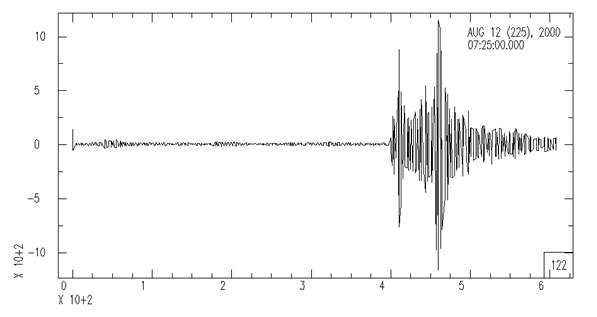SPYDER® - Near-real-time Seismic Data
SPYDER® (System to Provide You Data from Earthquakes Rapidly), acronym graciously provided by none other than Tim Ahern, is a near-real time seismic data acquisition system. The system, designed and supported by scientists at the University of Washington, operates at the IRIS Data Management Center (DMC) with the cooperation of many global partners (see list below). SPYDER® is triggered by special alert messages sent by the National Earthquake Information Center (NEIC) in Golden, Colorado. The alert messages give the time, location and magnitude of the earthquake. We use location and magnitude criteria to determine which seismic stations should be contacted for data retrieval. An event window of data is retrieved and archived for global events above the SPYDER® routine magnitude cutoff limit of 5.7 (5.5 if an event depth is greater than 100km). Earthquakes of magnitude 4.5 or greater occurring in the United States are also retrieved and archived. We recover primarily broadband (20 samples/sec) data using an event window of between 4 and 6 minutes. Long period data (1 sample/sec) requires an event window of an hour and we collect up to five hours of data for very long period (about 0.1 samples/sec) data. The entire process usually takes a few hours with some data available within tens of minutes after the earthquake in question.

SPYDER® is running (independently) at the following locations:
- IRIS Data Management Center (Seattle, Washington)
- University of Washington, Dept. of Geophysics (Seattle, Washington)
- ORFEUS Data Center (deBilt, The Netherlands)
- University of Hawaii, (Honolulu, Hawaii)
- University of Alaska, (Fairbanks, Alaska)
- Earthquake Research Institute (University of Tokyo, Japan)
- Institute of Geological and Nuclear Sciences, (Wellington, New Zealand)
- GEOFON, (Potsdam, Germany)
- Australian National University, (Canberra, Australia)
- Institute of Physics of the Globe, Paris, (Paris, France)
Our global network consists of 133 active stations. Data from the majority of these stations (77) are collected via Autodrm from hubs located at the Albuquerque Seismic Lab (ASL) for the IRIS/USGS network, the National Earthquake Hazards Program of National Resources Canada in Ottawa for the Canadian National Seismic network, the IRIS/IDA network at the University of California – San Diego, Russia, Pakistan, and the National Earthquake Information Center (NEIC). Twenty three stations are accessed via direct dial, twelve are internet connections to GEOSCOPE stations, nine are Internet connections to GEOFON stations, and the remainder are dialed remotely.
Accessing event data
Event data is accessible through either:
WILBER (Web Interface to Lookup Big Events for Retrieval)
Where you can view an epicenter map of the event with station raypaths, look at record sections of broadband, long period data, or very long period (if available), and individual station traces, see a list of the stations retrieved, look at a problem log, and the size and content of the SEED files. Data can be downloaded in a number of SEED or SAC formats including binary, ASCII, and compressed. View WILBER
The SPYDER® Events web page
Where you can also view an epicenter map of responding stations, record sections, see a listing of the SEED volume contents, and download either the entire binary SEED volume or individual station components in binary SAC format.
Viewing the SPYDER® home page gives you convenient access to WILBER, the SPYDER® events page, a list of the ten most recent significant global events, and a list of SPYDER® stations, as well as on-line documentation of the SPYDER® system for users worldwide.
April 2000 saw the transferring of the SPYDER® support and development torch from Peter Burkholder to Wallis Hutton. Oddly enough both did graduate work at the University of Wisconsin and once shared a computer lab. In-process updates at the IRIS DMC mean some changes for SPYDER® (see the FARM article in current issue).
23 IRIS/IU stations (see below) were switched from dial-up access to Autodrm in May when ASL added these stations to the Live Internet Seismic Server (LISS).
- ADK – Adak, Aleutians, Alaska
- COLA – College Outpost, Alaska, USA
- CTAO – Charters Towers, Australia
- GUMO – Guam
- HKT – Hockley, Texas
- INCN – Inchon, Republic of Korea
- KIP – Kipapa, Hawaii, USA
- KONO – Kongsberg, Norway
- MA2 – Magadan, Russia
- MSKU – Masuku, Gabon
- PAYG – Puerto Ayora, Galapagos
- PET – Petropavlovsk, Russia
- PMSA – Palmer Station, Antarctica
- POHA – Pohakuloa, Hawaii
- RCBR – Riachuelo, Brazil
- SPA – South Pole, Antarctica
- TATO – Taipei, Taiwan
- TIXI – Tiksi, Russia
- TUC – Tucson, Arizona, USA
- ULN – Ulaanbaator, Mongolia
- YAK – Yakutsk, Russia
This lead to considerably more efficient data collection but also raised issues of data format and the inflexible retrieval syntax of Autodrm. We are currently working to resolve these issues and provide SEED volumes for all Autodrm retrieved data.
Quality Control
Quality control is another favorite pastime of the new SPYDER®woman. Quality control measures implemented during the first half of 2000 were periodic checks of stations sending frequent error messages, the removal of known problem stations from the dial-up list, and the formal tracking of nonfunctional or unofficially abandoned stations. These measures not only saved on dial-up costs to down stations but also ensured frequent reviews of station health. Future QC plans include some automatic QC diagnostics for the SPYDER® data. The first quarter of 2000 SPYDER® was unusually quiet with only 91 events processed. This relative quiescence continued into the second quarter with only 112 events processed. Rumors of the demise of plate tectonics have begun to spread. Interested readers may consult the next IRIS newsletter for a definitive answer.
by Wallis Hutton (University of Washington)






